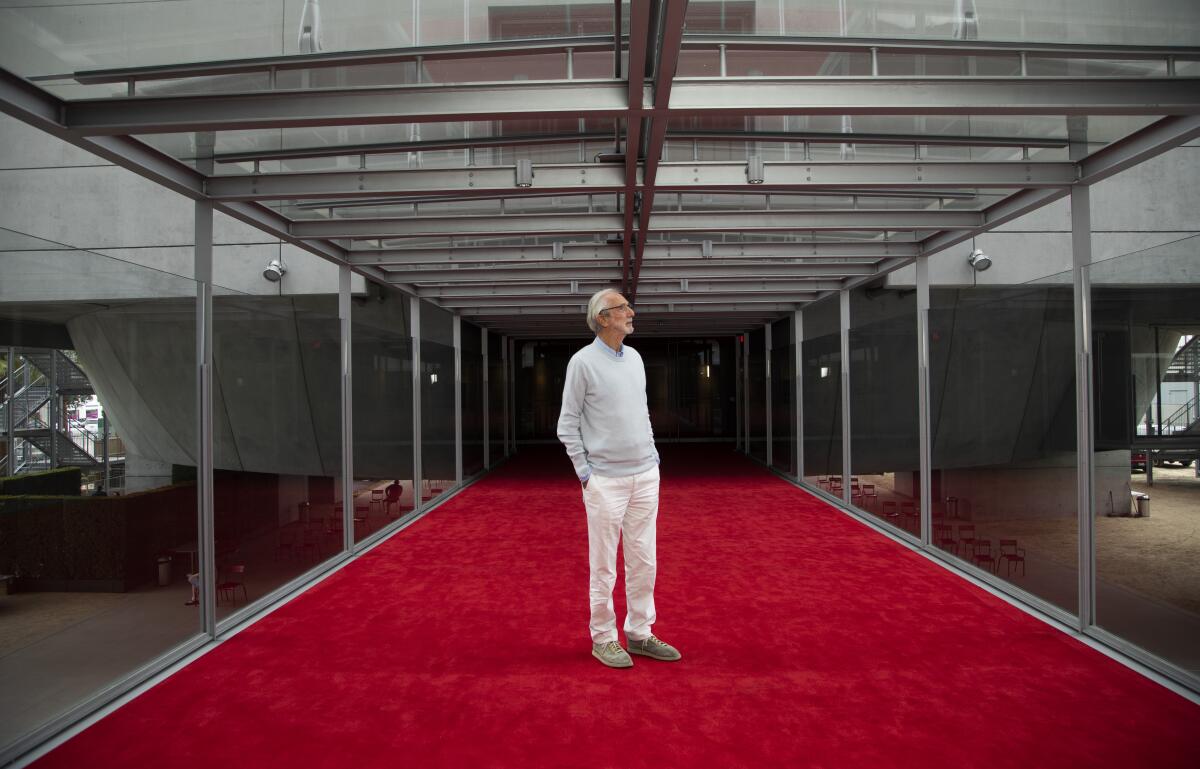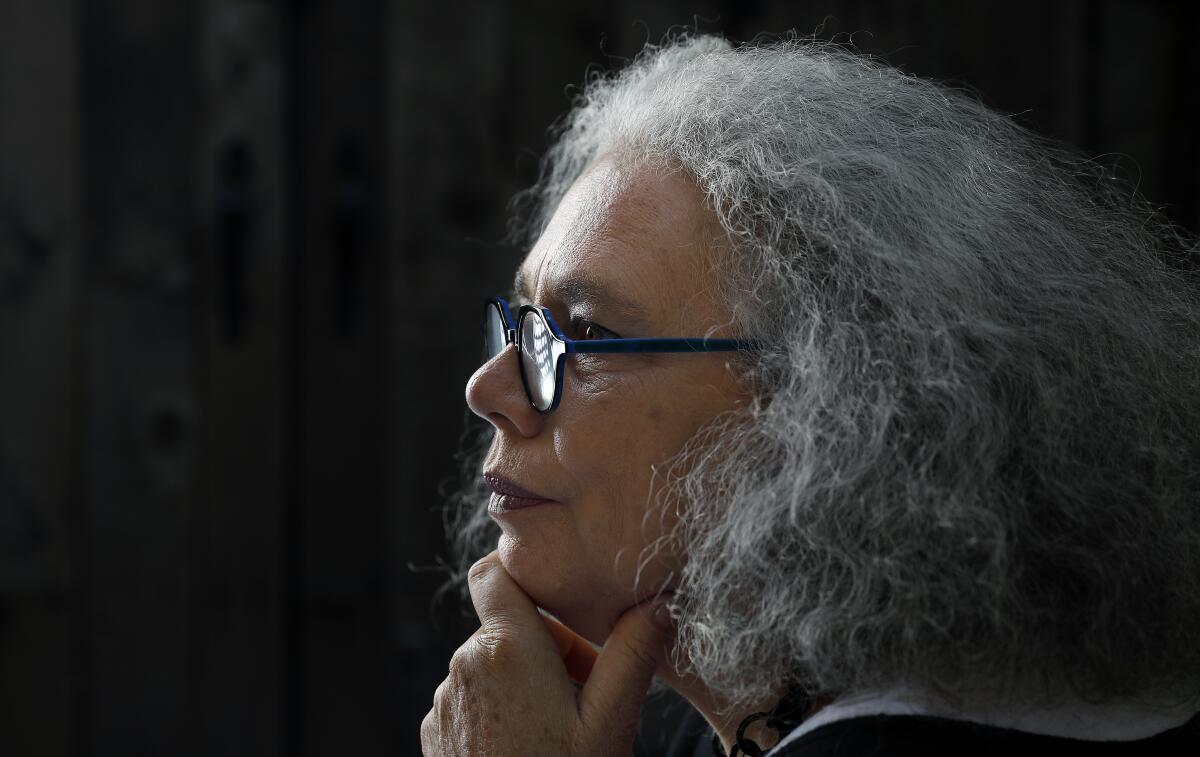Newsletter: The Ambassador Hotel is long gone. Pat O’Neill resurrects its ghosts
- Share via
I drank all the tequila at one of the Academy Museum’s recent unveiling parties and could really use an entire platter of modeum jeon right now. I’m Carolina A. Miranda, arts and urban design columnist for the Los Angeles Times, and I’m here with your weekly culture newsletter and L.A.’s most appetizing Korean fritters.
Remembering the Ambassador
Los Angeles filmmaker Pat O’Neill had only ever been inside the Ambassador Hotel once in his life before he began work on a project about the building that would absorb him for years. It was the 1950s. He was a boy. And his great-grandfather was visiting from Kansas.
“He was a grand sort of person,” O’Neill says of his great-grandfather. “He stayed there, and we went to visit him and have dinner with him.” At that point, the Ambassador, which had opened its doors in 1921, was more than three decades old. “It already was quite worn,” he recalls.
He hardly could have imagined then what would become of the building — or that he would spend years in the 1990s working on a film that would take place within its walls.
Designed by architect Myron Hunt in a Mediterranean style, the Ambassador Hotel, for decades, was the epitome of glamour in Los Angeles — the stamping ground of Rudolph Valentino, F. Scott Fitzgerald, Elizabeth Taylor, Frank Sinatra, Joan Crawford and, on at least one occasion, Albert Einstein. It served, for a time, as a home to the Academy Awards, and its famed Cocoanut Grove nightclub boasted Casbah-inspired interiors studded with fake palm trees (leftover set pieces from Valentino’s 1921 silent film “The Sheik” — or so the legend goes).
By the ’60s, the hotel’s glamour (and the neighborhood’s) had faded, and its eventual demise was precipitated by the assassination of Robert F. Kennedy in its pantry in 1968. After that, the Ambassador became associated in name with Kennedy’s death. “People just didn’t want to come into the place except to gawk at the pantry, the hotel’s former publicist Margaret Burk told Los Angeles magazine in 1998.
In 1989, the Ambassador shut down. Following a protracted battle over the site that involved the L.A. Unified School District and Donald Trump, much of the hotel was demolished in 2005. The site is now occupied by the Robert F. Kennedy Community Schools, an educational complex, with parts of the old hotel — a diner turned into a teachers’ break room, the Cocoanut Grove rebuilt as an auditorium — integrated into the new design.
Make the most of L.A.
Get our guide to events and happenings in the SoCal arts scene. In your inbox every Monday and Friday morning.
You may occasionally receive promotional content from the Los Angeles Times.
Remarkably, O’Neill, an artist and experimental filmmaker who grew up in Los Angeles and taught for spells at UCLA and CalArts, managed to gain access to the Ambassador when it was in its somnolent state in the 1990s and early 2000s. At the time, the hotel was empty, in a process of continuous decay and employed as the occasional film set (“Pretty Woman” was shot there) and a training site for the LAPD’s SWAT team.
Through a friend, O’Neill secured permission to shoot the hotel, and he proceeded to create a startling and surreal visual record of the Ambassador’s dilapidated guest rooms, its grand banquet halls, the empty swimming pool and the labyrinthine passageways through which Kennedy was led to his unexpected death.
To give the footage an uncanny feel, O’Neill (who for years had a day job working in special effects) built a special rig that could shoot in time lapse — one frame every 10 seconds — so that on playback, the action would move with greater speed. He captured the building’s architecture, but he also recorded plays on light and time. Over these images, he layered ghostly images of actors inhabiting the hotel, as well as performers engaged in frantic dance sequences.
“The Decay of Fiction,” as his film is called, debuted in 2002. To watch it is to see a building dream.
In 2018, O’Neill reconceived the film as an immersive, five-channel art installation that went on view at Philip Martin Gallery in Culver City. It is one of those shows I regret not covering at the time. Thankfully, I get a do-over because the installation version of “The Decay of Fiction” is now on view at Mitchell-Innes & Nash in New York.
The installation takes a film about architecture and turns it into an architectural work.
For O’Neill, who in 1989 created a meditative film, “Water and Power,” about the ways in which water makes feasible the very idea of Los Angeles, the works focused on the Ambassador were an opportunity to immerse himself in a singular Los Angeles building. “I liked the presence of it,” he says of the hotel. “I like dealing with buildings and neighborhoods that have interesting histories.”
In a quiet and surreal way, he captures those histories and preserves them so that the Ambassador, though long gone, manages to remain with us in spirit.
Pat O’Neill, “The Decay of Fiction,” is on view at Mitchell-Innes & Nash in Manhattan through Oct. 23, miandn.com.
Tony! Tony! Tony!
It’s Tonys season! Wait, is it? Or is time in the pandemic a flat circle and it’s simply that the much-delayed Tony Awards finally hit the stage? All of the above. Times theater critic Charles McNulty was on the case, and he reports that this was one awards show that was definitely of our time. “Not even the most bulldozing Broadway producer could pretend that we’re back to normal,” he writes. “But this reunion of the Broadway community jogged the memory of what we’ve been missing these last 18 months — virtuosity and emotional courage made flesh.”

Jessica Gelt, in the meantime, reports on how the show’s producers seemed intent on making it as difficult as possible to watch the Tonys. Part of the show aired on CBS; the other part, on Paramount+. And, oh, “CBS is continuing its archaic tradition of delaying its broadcast in the Pacific time zone until three hours after East Coast fans get to watch live.” Because Lord knows no one would ever give away the winners via social media or a news alert. 🙄
Here’s the full list of winners. “Moulin Rouge! The Musical” had 10 wins, while “Jagged Little Pill” took home two awards.
Matthew López took home the prize for best play for “The Inheritance,” becoming the first Latino to win the top drama category. Except that López doesn’t use the word “Latino,” preferring “Latiné,” an alternative to “Latinx,” which does away with the gender binary employed in Spanish. Gelt explains.

On and off the stage
Theater had a joyous moment this week, but it is still contending with reckoning. The Times’ Ashley Lee reports on the Williamstown Theatre Festival in Massachusetts, the influential Berkshires festival that has long been an important professional pit stop for up-and-coming theater workers. She spoke with more than two dozen current and former staffers contending with what they allege are “repeated safety hazards and a toxic work culture under the guise of prestige.”
As former lighting department head Brandon Bagwell told her: “The festival is trying to look like they have soil that is incredibly nutritious, but artists are being brought into soil that does not actually foster their growth.”
Enjoying this newsletter? Consider subscribing to the Los Angeles Times
Your support helps us deliver the news that matters most. Become a subscriber.
After nearly two years of pandemic closures, the Center Theatre Group has announced its 2022 lineups for the Mark Taper Forum and Kirk Douglas Theatre. Expect Jeremy O. Harris’ “Slave Play” and Rajiv Joseph’s “King James,” among other very intriguing works.
Meanwhile, at the academy
After years of planning, construction, musical chairs on the executive team and other delays, the Academy Museum finally opened this week. Naturally, there was a gala — with appearances by Spike Lee, Nicole Kidman, Laverne Cox, Cher, Lady Gaga and countless other stars. (I’m loving Ruth E. Carter’s brilliant red gown.)
The red carpet for the event was green! No doubt a nod to the design of the building’s Ted Mann Theater, whose seats are also green. The shade is also a favorite of the building’s lead architect, Renzo Piano, who took me on a tour earlier this week.
Piano told me that he would very much like it if all of Los Angeles would stop calling the spherical Geffen Theater the “Death Star.” He prefers “the Bubble” or “flying vessel.” The building, he says, is about love, not death. “For me, it’s like a flirt. It’s a little love story between the older lady there, the May Co. building ... and we have the young flying vessel landing here.”

My colleague Greg Braxton got to hang with a true GOAT — greatest of all time. That’d be filmmaker Spike Lee, who has a gallery devoted to all of his inspirations, filmic, musical and otherwise. “I’m elated,” Lee says of the installation. “I’m happy and honored that this exhibition is here for the opening of the museum.”
New York Times film critic Manohla Dargis has a review of the Academy Museum’s exhibitions: “The industry’s ugliness, its racism and sexism, is directly addressed, but the emphasis is on diversity and pluralism, not past and present sins. Call it a museum of good intentions.”
ICYMI, here is The Times’ guide to visiting the museum.
In other academy-adjacent news: The museum’s chief artistic and programming officer, Jacqueline Stewart, was named a recipient of a MacArthur fellowship this week (a.k.a. the “genius” grant). Among the winners were husband-and-wife L.A. filmmakers Cristina Ibarra and Alex Rivera, who received grants for their individual bodies of work — though they have collaborated on at least one occasion: the 2019 hybrid documentary-feature “The Infiltrators.”
Classical notes
Classical music critic Mark Swed has been listening to the birds, the suite of birdsong-inspired compositions by Olivier Messiaen, that is. Piano Spheres staged a performance of the 13 solo pieces, titled “Catalogue d’Oiseaux,” at the Audubon Center at Debs Park. “The evocations come across not as translations of one kind of sound into another,” writes Swed, “but as hearing birds speak in astonishing piano accents.”

It has been a historic season for the Los Angeles Philharmonic at the Hollywood Bowl, and Swed reports that it has been “the most satisfying” in memory. “Graying and at 40 well past his ‘Dude’ days,” he writes, Phil musical director Gustavo Dudamel “has become a magisterial, if still youthfully exuberant, music director who takes everything he conducts with great seriousness and great joy.”
Visual culture
Artist Alison Saar has a gangbusters two-part survey on view at the Armory Center for the Arts in Pasadena and the Benton Museum of Art at Pomona College (which is looking very snazzy in a beautifully proportioned new building designed by Machado Silvetti). When “Alison Saar: Of Aether and Earthe” opened in July, Times art critic Christopher Knight wrote of the work that “it’s hard to think of any recent art more salient right now.”
This week, I sat down for a Q&A with Saar to talk about how her work has been shaped by race, history, politics and womanhood. We also talk about how she has reimagined the stereotypical character of Topsy from “Uncle Tom’s Cabin” for our age. “I was intrigued with her owning that she is fierce,” she tells me. “In that fierceness, there is resilience. She is ready to fight back.”

Definitely related: Independent arts writer Colony Little talks to Saar’s mother, Betye Saar, about her watercolors of Black dolls, on view at Roberts Projects.
What I’m reading (and writing)
“We all identified with the notion of reusing coffee cans for starting veggie seeds or storing leftovers in old sour-cream containers — and we all understood the power of transforming the shame that clings to such acts into celebrations of pragmatism.” Poet, artist and essayist Raquel Gutiérrez has an absolutely beautiful essay on rasquachismo and queer spaces in Places Journal. The term, which emerges from Mexican slang used to denote something vulgar or of little value, has been embraced by artists and urbanists who see in it an aesthetic of resilience.
In July, while I was in New York, I saw El Museo del Barrio‘s new triennial, “Estamos Bien – La Trienal 20/21” (which closed last week). In a piece for the New York Review of Books, I write about how the show captures a moment in which Latino identity is in wild flux. It’s a show where rasquachismo is definitely present.
Happy Hispanic Heritage Month!
Speaking of Latino identity: “While big broadcast media would like us all to gather round the old tube and watch a variety show of similarly tinted celebrities wax poetic about our collective glories,” writes Daniel Hernandez, “the emoji generation has had other ideas.” Hernandez writes about how Hispanic Heritage Month has been turned into a meme — reflecting “the state of ambivalence that we have about ourselves.”
Essential happenings
Matt Cooper rounds up the weekend’s best happenings, including a series of outdoor dance performances choreographed by Jacob Jonas that kick off this weekend. Organized by the Wallis, this weekend’s shows will be in Century City; future gigs will take place in other locations, including downtown and in Santa Monica.
Passages
Carlisle Floyd, a composer and librettist whose operas explored the culture and traditions of the South, including the 1955 opera “Susannah,” has died at the age of 95.
As part of its Overlooked No More series, the New York Times pens a belated obit for the Mexico-based surrealist painter Remedios Varo, who died in 1963 at the age of 54. “Her style was reminiscent of Renaissance art in its exquisite precision,” writes Julia Bozzone, “but her dreamlike paintings were otherworldly in tone.”
In other news
— I am very into this photo essay on Dominican car culture.
— Aaron Sorkin speaks out (finally) about working with producer Scott Rudin, whose alleged bullying work style was the subject of a Hollywood Reporter exposé in the spring.
— The New Yorker’s Alex Ross writes about the architecture of Richard Neutra, including the Lovell Health House, recently acquired by gallerists Iwan and Manuela Wirth.
— “Unapologetically utilitarian.” A design history of the dingbat.
— Construction has kicked off on a 19-story housing project by Joseph Wong Design Associates for the unhoused on skid row.
— How did a Cameroonian teenager’s drawing end up in a painting by Jasper Johns? Geoff Edgers of the Washington Post has the story.
— The Underground Museum has awarded its inaugural Noah Davis Prize to honor innovative curators. This year’s winners include Jamillah James of the ICA LA, as well as Candice Hopkins and Thomas Jean Lax.
— A grant from the Svane Family Foundation will allow the Fine Arts Museums of San Francisco to acquire works by local artists.
— A report by Monument Lab and financed by the Mellon Foundation shows that of the 50 individuals most represented in 50,000 U.S. monuments, 88% are white men and half were slave owners.
— “Behind the Frame” is an artistic video game that explores art, cats, love and loss.
And last but not least ...
The winning submissions of the miniature dry stone wall building contest in Ireland. (Hat tip to @imagineterrain for the wonder that is this link.)
The biggest entertainment stories
Get our big stories about Hollywood, film, television, music, arts, culture and more right in your inbox as soon as they publish.
You may occasionally receive promotional content from the Los Angeles Times.




